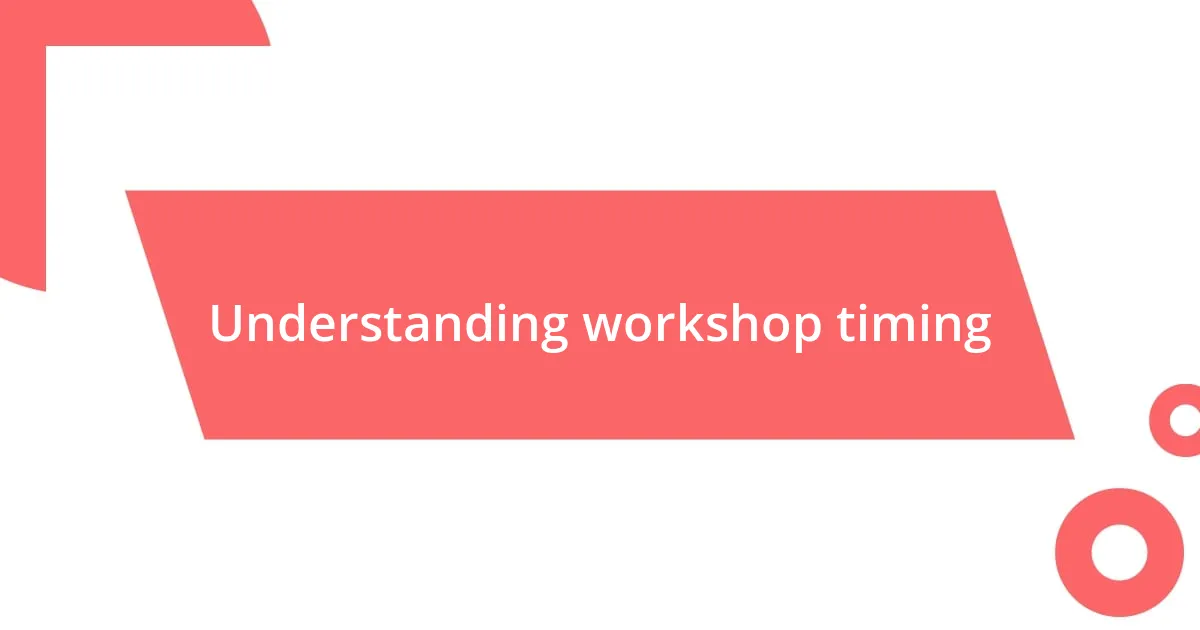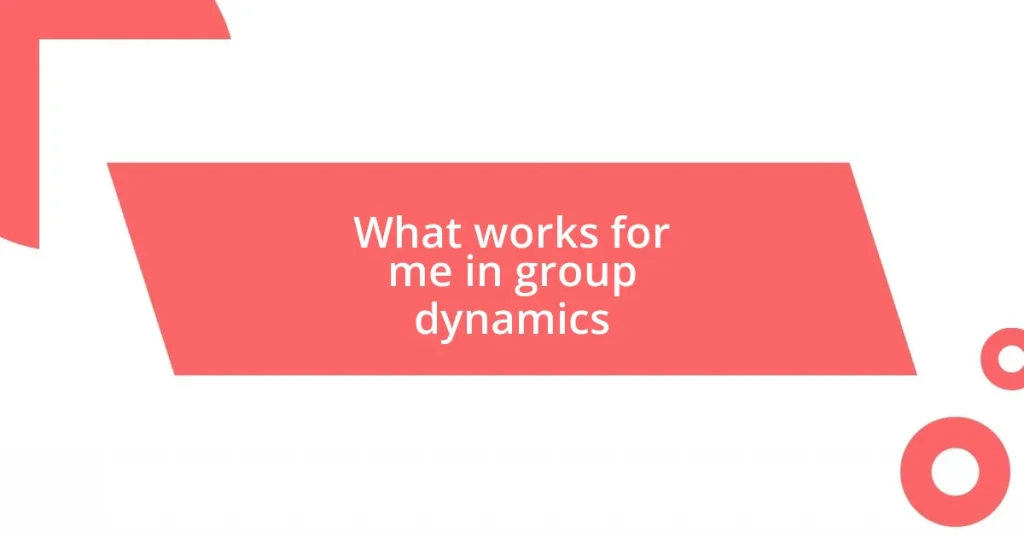Key takeaways:
- Effective workshop timing enhances participant engagement and encourages open discussions.
- Setting clear and specific goals helps maintain focus and boosts participant involvement.
- A well-structured agenda balances content delivery with flexibility to accommodate real-time dynamics.
- Incorporating breaks and using time management tools significantly improve workshop outcomes and creativity.

Understanding workshop timing
Understanding the timing of a workshop can be a game changer for its success. I remember a workshop I hosted that ran over time because I didn’t account for participants’ questions. The energy in the room shifted when discussions went off track, leading to frustration rather than engagement. Have you ever noticed how a tightly packed agenda can suffocate creativity?
It’s crucial to balance content delivery with the natural ebb and flow of conversation. I often intentionally leave a little buffer between sections, allowing participants to digest information and share insights without feeling rushed. It’s in these pauses that I’ve witnessed the most genuine breakthroughs—those “aha” moments that spark richer discussions and deeper learning.
Timing isn’t just about schedules; it’s about sensing the room. During one of my favorite workshops, I felt the energy dip as we approached a lengthy topic. Rather than pushing through, I pivoted, bringing in a quick interactive exercise. The shift not only re-engaged participants but also underscored an important lesson: flexibility in timing speaks volumes about leadership and awareness in the workshop environment.

Setting clear workshop goals
Setting clear workshop goals is essential for maintaining focus and direction. When I plan a workshop, I always start by defining what I want participants to take away. Recently, I conducted a workshop where I set the goal of enhancing teamwork skills. It felt invigorating to see how everyone rallied around that common purpose. Have you ever noticed how aligned goals can energize a group?
Another aspect of goal-setting is being specific. Instead of a vague goal like “improve communication,” I promote setting targets such as “enhance feedback techniques.” This approach allows participants to understand exactly what we’re aiming for. In my experience, when the objectives are tangible, participants feel more engaged and are more likely to contribute meaningfully to discussions.
Lastly, I find that it’s vital to revisit these goals throughout the workshop. After each section, I pause and ask, “How are we aligning with our objectives?” This not only reinforces our purpose but also opens the floor for any adjustments needed. I remember a workshop where a shift in our goals mid-session led to unexpected yet fruitful discussions. It’s moments like these that remind me how adaptable we need to be in our planning.
| General Goals | Specific Goals |
|---|---|
| Improve communication | Enhance feedback techniques |
| Encourage creativity | Develop brainstorming skills through structured activities |

Developing a structured agenda
When I develop a structured agenda for a workshop, I always consider how crucial it is to create a roadmap that guides us through the day. I once crafted an agenda that seemed flawless on paper, but I quickly realized it didn’t account for different participants’ learning paces. By allowing for some flexibility, I turned that experience into a lesson; now I include time slots specifically for questions and feedback, ensuring everyone feels heard and valued.
Here’s a simple approach to structuring an agenda that I’ve found effective:
- Start with a captivating opening: Set the tone with an engaging introduction or icebreaker.
- Outline main topics clearly: Break content into sections that logically flow from one to another.
- Allocate time for each section thoughtfully: Consider both delivery and interaction, allowing enough space for discussion.
- Include breaks strategically: This keeps energy levels up and gives participants time to recharge.
- Leave room for adjustments: Build in flex time to cater to unplanned discussions or deeper dives into specific topics.
By building these elements into my agendas, I’ve noticed a positive shift in participant engagement and overall satisfaction. Balancing structure with adaptability transforms an ordinary workshop into a dynamic experience, inviting everyone to contribute their unique perspectives.

Incorporating breaks effectively
Incorporating breaks effectively can make a remarkable difference in workshop dynamics. I’ve learned that scheduling short breaks every 60 to 90 minutes not only rejuvenates participants but also inspires creativity. I once led a workshop where I mistakenly skipped breaks, and the atmosphere quickly turned stiff and disengaged. That taught me the hard way that even brief pauses can spark new ideas and foster conversations.
During breaks, I encourage participants to step away from their chairs, mingle, or even take a quick walk if possible. I love watching as bonds form over a simple cup of coffee. This interaction turns into a valuable brainstorming session, often leading to insights that we might later discuss in depth. Does anyone else feel that those casual chats often lead to the richest ideas?
Another powerful strategy I’ve found is to integrate a few light-hearted activities during breaks, like quick stretching or a fun quiz related to the workshop topic. I remember a time when I introduced a mini-game centered on our goals, and it instantly lifted the energy in the room. Everyone was laughing and seemed more open when we returned to our seats. Balancing structured time with infectious joy creates an environment that encourages active participation and boosts morale significantly.

Utilizing tools for time management
Utilizing various tools for time management has significantly improved my workshop experiences. For instance, I rely on digital timers to keep track of each session’s length. Once, I set a timer during a brainstorming activity, and it created a buzz of excitement; everyone felt the urgency of focusing their thoughts, and we ended up generating ideas more efficiently than I had anticipated. Do you ever wonder how a simple tool like a timer can transform engagement?
In addition to timers, I’ve found project management software, such as Trello or Asana, to be invaluable for organizing tasks within the workshop. I’ve used these tools to outline session goals and assign responsibilities to co-facilitators. It’s remarkable how visual organization can reduce overwhelm; seeing tasks laid out clearly enables us to manage our time better and stick to the agenda. Have you ever experienced that sense of clarity when goals are neatly defined?
Lastly, incorporating collaborative tools like Google Docs or Jamboard allows participants to contribute in real-time, which keeps them involved and aware of time constraints. I vividly recall a session where we used Jamboard for group brainstorming. The interactive element made time fly, as participants eagerly added their ideas. It’s fascinating how technology can foster a sense of urgency and excitement—do you notice the difference when engagement tools are in play?

Evaluating time management outcomes
Evaluating time management outcomes requires a critical look at how effectively the planned time aligns with actual engagement and content delivery. I recall a workshop where I meticulously mapped out the schedule, only to find that we ended up spending twice as long on a discussion than anticipated. It was a bit daunting initially, but it highlighted the importance of being adaptable—I learned that sometimes the best insights come from allowing space for organic conversation.
After each workshop, I reflect on what worked and what didn’t, often seeking feedback from participants. One time, I sent out a quick survey asking, “Did our timing feel right to you?” The responses were eye-opening: many appreciated the extended discussions, while others craved more structured time for hands-on activities. Hearing this made me realize that evaluating time management isn’t just about the clock; it’s also about the overall satisfaction and learning experience of the attendees.
I also like to compare the pre-set outcomes with actual achievements. For example, if we planned to generate ten actionable ideas but came out with fifteen, that’s a clear win! I find it rewarding to celebrate those moments while also considering how I can tweak the agenda next time to make even better use of our time together. Have you ever had that feeling of perfectly balancing structure with flexibility? It’s a beautiful dance and one that requires constant evaluation and adaptation.















